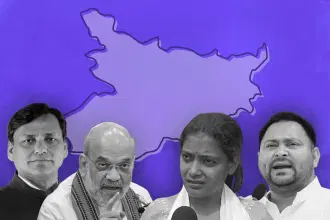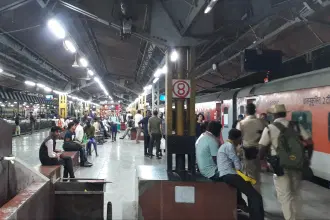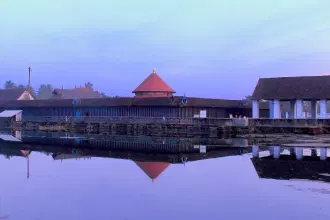Uttar Pradesh
UP's Electricity Crisis: Will Yogi Pull The Plug On His Power Minister?
Nishtha Anushree
Aug 04, 2025, 12:41 PM | Updated 12:46 PM IST
Save & read from anywhere!
Bookmark stories for easy access on any device or the Swarajya app.
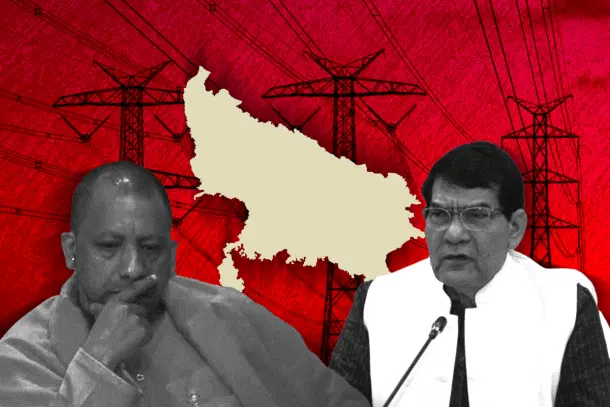
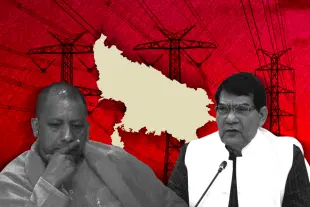
A diversion tactic by Uttar Pradesh (UP) Power Minister Arvind Kumar Sharma ironically drew the entire nation's attention to the state's electricity crisis.
Last month, when the Minister visited Sultanpur district, locals approached him to complain about frequent power outages, claiming they were receiving electricity for only three hours a day.
Instead of addressing their concerns, Sharma responded with slogans like "Jai Shri Ram" and "Jai Bajrang Bali", before getting into his car and leaving.
The response was widely interpreted as the Bharatiya Janata Party's (BJP) strategy to deflect from governance failures and development issues, and received widespread backlash on social media.
The viral video became a catalyst for citizens across UP to voice their frustrations about the poor electricity supply in their areas.
In response to the mounting criticism, UP Chief Minister Yogi Adityanath convened a high-level review meeting with the power department on 25 July.
He expressed dissatisfaction over recurring power tripping, overbilling, and unscheduled outages, and directed officials to identify the problem areas and resolve them.
Later, Yogi posted on X: "There is sufficient availability of electricity in Uttar Pradesh. The Uttar Pradesh government is fully committed to ensuring uninterrupted power supply to all consumers, including citizens, commercial establishments, and industrial units, without any discrimination."
However, this statement triggered another wave of public outrage. Citizens responded directly to it by alleging that the ground reality is far from the official claims.
The Issues
In June 2025, UP recorded a peak power demand of 31,486 megawatts (MW), which Chief Minister Adityanath claimed was fulfilled"successfully".
However, data shows that the total electricity supplied in that month was 16,930 million units (1 unit = 1 kilowatt-hour). After adjusting for average transmission and distribution losses of 15 to 20 per cent, this translates to a continuous average supply of about 19,000 to 20,000 MW.
This is significantly lower than the peak demand of 31,486 MW, suggesting the state may not have been able to maintain peak supply levels throughout the day.
Government's own data reveals that in June, uninterrupted power supply averaged 24 hours in urban areas, 21.5 hours in tehsil towns, and 18 hours in rural areas.
Complaints of frequent outages poured in from all parts of UP — from industrial centres like Noida to districts in the Awadh region such as Ayodhya and Sultanpur, the capital Lucknow, and eastern districts including Maharajganj, Gorakhpur, and Prayagraj.
Adarsh Yadav, a student at Awadh University, told Swarajya that they face power cuts lasting 10 to 12 hours daily. Another resident said, “The situation is even worse in villages and in smaller cities like Jaunpur, Rae Bareli, Pratapgarh, and Barabanki.”
A Ghaziabad resident said, “The power situation is visibly poor. There has been no continuous improvement since Yogi's first term, and this year, things are deteriorating further. Even last year, power cuts were noticeable.”
Local media reports confirm that many villages are getting only three to four hours of electricity daily, while cities face power cuts of up to six hours.
Even the Power Minister himself has not been spared. In March, he addressed an event in his hometown Mau in complete darkness. In July, a 10-minute outage delayed the inauguration of a 5D motion theatre in Moradabad.
When the Issues Began
As per several UP residents, who talked to Swarajya, the electricity supply significantly improved during Yogi Adityanath's first term from 2017 to 2022.
Then-Power Minister Shrikant Sharma was seen as proactive, focusing on access and infrastructure expansion, particularly in rural electrification and increasing supply hours.
However, he was replaced by A K Sharma in Yogi's second term. The troubles began to be visible in May to June 2022, with reports of increased power outages, especially in villages of Bundelkhand and Purvanchal, which allegedly got less than 10 hours of electricity.
2023 turned out to be worse, with a surge in demand (over 28,000 MW) during heatwaves, which UP Power Corporation Limited (UPPCL) could not manage, leading to 8 to 12 hour-long power cuts in rural and semi-urban areas.
In 2024, the power outages started affecting larger cities like Lucknow, Kanpur and Prayagraj, with frequent two to three-hour outages daily. The situation has further deteriorated in 2025, with the effect of power outages being seen across the state.
"There is a slight deterioration compared to the peak availability of 2023. The years from 2017 to 2023 witnessed progressive improvement. People became accustomed to that and are complaining now," a Bulandshahr resident told Swarajya.
While one of the reasons for these issues is growing industrialisation and urbanisation, which raise power demands, making it difficult to meet, another reason is the growing discord between Minister Sharma and the department bureaucrats.
Although the Yogi government has increased the power availability in the state from 11,800 MW in 2017 to 20,000 MW in 2025, the demand has more than doubled from 13,000 MW in 2017 to 30,000 MW in 2025, making it challenging to meet.
Moreover, there is some resistance to the proposed privatisation of power distribution companies (DISCOMs) and the mandatory installation of smart metres to prevent electricity theft, which are believed to be disturbing the functioning of the power department.
Is the Situation Really Bad?
While power cuts have undoubtedly increased in UP recently, the severity of the crisis may be amplified by the high expectations set during Yogi's successful first term, several locals believe.
The Ghaziabad resident said, "11 years ago, power cuts for six hours daily were the best scenario. But now it is considered the worst and appears very noticeable. Earlier, people expected long cuts after heavy rains, but now, the same thing makes them mad."
Similar sentiments were echoed by the Bulandshahr resident, who said, "When 16 hours of load shedding was the norm, nobody called up the superintendent engineer for a power cut. After achieving near 24-hour availability, it is possible to do that."
A BJP worker from Sitapur, Prateek Pandey, defended the power cuts, arguing that the outages were being exaggerated due to the extreme heat, which made even a few minutes without electricity feel unbearable.
For the rainy season, he explained, "The rains disrupt the power supply as there are more instances of transformer blasts. Yes, the government is at fault for not preparing for these weather conditions, but not as much as is being portrayed."
He asserted that most villages are receiving up to 18 hours of electricity daily, except in cases of technical faults or weather-related disruptions. He also maintained that power interruptions between April and September are common and not unusual.
In contrast, a resident of Ayodhya countered these claims, saying the outages are very real, especially since even BJP supporters are voicing concerns. However, he believed the issue stemmed more from internal technical problems in the department than from a shortage of power supply.
Whom to Blame
Minister Sharma chose to blame a "few anarchic officials" who are bringing a "bad name" to the power department, in a long social media post on 28 July.
Highlighting that the power department officials have called strikes four times in his three-year tenure, Sharma alleged these strikes were "externally motivated" to undermine his position.
He also mentioned the protests against the privatisation and clarified his position that he was not solely responsible for this decision, since he "didn't even decide the transfer of a junior engineer."
In short, Sharma contended that certain officials were sabotaging the department's functioning due to discontent against privatisation or ill motives against Sharma, leading to power outages.
He has also warned the power department officials that action would be taken against them, since everyone's accountability is fixed.
While it is true that privatisation plans have faced resistance from within the department, shifting the entire blame for the ongoing power crisis onto officials suggests a deflection from the Minister’s own responsibility.
Political observer Amit Yadav told Swarajya, "Bureaucrats remain the same. It depends on the Minister how he gets work done. It appears that Sharma has been unable to manage the department."
If Sharma indeed feels that a few officials are playing a spoilsport, as a Minister, he has the power to deal with them and bring the department back on track.
Moreover, distancing himself from the decision to privatise DISCOMs undermines the Yogi government's ambitious initiative. As a power minister, he should have backed the government fully and convinced his department officials to support it.
Is Sharma Incompetent?
Sharma has a long experience as an Indian Administrative Service (IAS) officer in Gujarat, where he was considered close to then-Chief Minister Narendra Modi. When Modi became Prime Minister in 2014, he brought Sharma along with him to the Centre.
Since then, Sharma held several key roles like Joint Secretary, Additional Secretary and Secretary in the Ministry of Micro, Small and Medium Enterprises (MSME), before opting for voluntary retirement in 2021.
In the second Yogi Adityanath government, he was brought into state politics via the Legislative Council and appointed as a Cabinet Minister. Given his longstanding association with Modi, it is widely believed that his induction was backed by the PM himself.
In addition to the energy portfolio, Sharma also oversees the urban development department. However, despite having a promising career as a bureaucrat, Sharma appears to have failed as a minister, given the minimal improvements in both departments.
UP locals complain not just of frequent power outages, but also slow progress in urban development. Even the capital city, Lucknow, complains of poor waste management and poor public infrastructure, like street lights.
Similar to how Sharma has failed in pushing for privatisation of DISCOMs in the power department, in the urban development department, he has often failed to manage issues between city development authorities and municipal corporations.
The Political Implications
Sharma's failures as a Minister will only pile up the growing anti-incumbency against the Yogi Adityanath government, which is already struggling with allegations of 'bureaucratic rule' and misgovernance in various sectors.
Given the fact that the electricity supply is closely related to people's lives, even small disruptions can have heavy electoral costs. Yogi understands this very well, and hence, he was quick to address these issues in a high-level review meeting.
“Electricity is no longer just a service; it reflects the public’s trust and the sensitivity of governance,” Yogi said during the meeting, suggesting that he understands the gravity of the situation.
The UP CM also emphasised accurate billing and said, "Instances of inflated or incorrect billing erode public trust and damage the department’s credibility, which is unacceptable. Efforts must be made to improve billing efficiency.”
He highlighted that since the government has provided record budgetary support for strengthening power generation, transmission and distribution, lapses would not be accepted and accountability must be fixed at every level.
While it remains to be seen whether Yogi's intervention will resolve the power department issues, the upcoming Cabinet reshuffle is also an opportunity for the UP CM to replace Sharma, if Yogi finds him incompetent as the power minister.
The much-anticipated Cabinet reshuffle in UP is likely to come after the state BJP unit picks its new president. It will be aimed at fighting anti-incumbency, similar to what the BJP did in Gujarat in 2021, to emerge victorious in the 2022 assembly election.
Sharma himself appears to have understood that he might be ousted or replaced in the upcoming overhaul, as is apparent from his newly seen agility in matters related to his department.
Recently, Rs 97 crore were approved for uninterrupted power supply in Noida, and several department officials were suspended over power outages. Sharma has also given specific instructions to officials to resolve the weak areas.
He was even seen indulging in on-camera gimmicks to give the impression that he was coming down heavily on officials and holding them accountable for any malfunction.
It remains to be seen whether these optics will let Sharma continue as a minister, but ultimately, it is CM Yogi who will have to bear the costs of any misgovernance, especially when the opposition parties are ever-ready to exploit these faults.
Nishtha Anushree is Senior Sub-editor at Swarajya. She tweets at @nishthaanushree.

